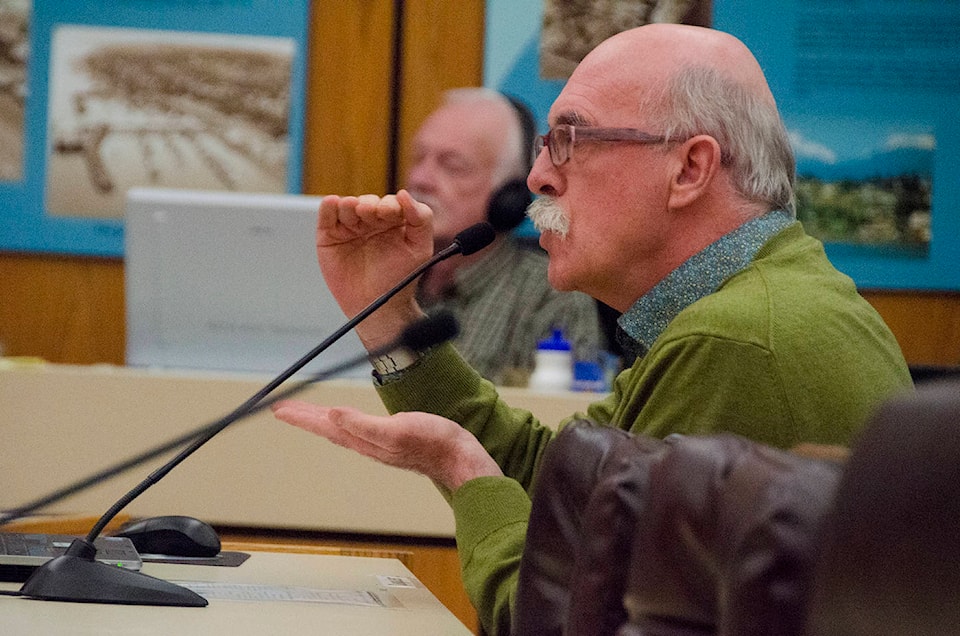City council heard two more presentations on Monday night about the proposed Upland Landfill application currently before the province waiting for approval.
At last meeting, council heard from the province when representatives from the Ministry of Environment and Climate Change (ENV) came to town to talk about the process used in determining approval for proposed landfills, and this week it heard from Dr. Gilles Wendling – a hydrogeologist hired by the Campbell River Environmental Committee (CREC) – and representatives from Upland itself.
Dr. Wendling said he has concerns surrounding the application simply because, in his view, there hasn’t been enough research done on the direction of water flow through the bedrock and aquifers surrounding the proposed pit. Should the liners of the proposed pit fail, Wendling says, it is possible that contaminants could flow through fissures in the bedrock – or in underground aquifers – into nearby Rico Lake, which connects to McIvor Lake and down into where Campbell River gets its drinking water.
“The groundwater flow in the bedrock still hasn’t been defined,” Wendling says. “This is concerning, because it may prove to be a risk to Rico Lake.”
Wendling’s argument against the proposed landfill is basically that there just simply haven’t been enough studies done to show the actual make-up of the ground under the pit to give him confidence that the nearby Campbell and Quinsam systems would not be in danger from any future possible leaks from the site.
“We may have a network of fractures in the bedrock with groundwater coming from the hill (behind the upland site and traveling under the site) and moving into Rico Lake,” Wendling says. “We don’t know right now because it hasn’t been characterized. We’ve pushed to have the groundwater regime defined, but it still hasn’t been defined. We’re concerned about that.”
RELATED: Province nears decision on Upland landfill application
Wendling says the mapping that has been done shows an aquifer that runs below the area is deep enough that it shouldn’t pose a problem in terms of carrying possible contaminants into the Campbell or Quinsam River systems. He also claims, however, there is the possibility that there is a second, unmapped aquifer, closer to the surface, that could carry contaminated liquid directly into Rico Lake in the event of a leak. He says after a recent visit to the site in December, the floor of the pit was too wet for there not to be groundwater very close to the surface, because the pit itself is designed to drain water away from the surface very quickly.
Upland’s technical consultant Greg Ferraro disputed that assessment during Upland’s presentation, saying the standing water in the area in question was caused by a recent deposit of fresh material the day of Wendling’s visit – material which doesn’t drain as quickly as the gravel that normally occupies the bottom of the pit – and the fact that it had been raining steadily for three days prior to his visit.
The presentation by Upland also highlighted the safety measures that are being proposed to be in place once the site is constructed, as well as the monitoring regimen that will be performed to ensure the safety of the nearby lakes and groundwater.
Terry Stewart and his consultants say that the double-lined pit will be built to withstand a 1-in-2,500 year earthquake and monitoring will take place not only during the operation of the facility, but also for 30 years after its closure – a 50-year commitment to ensuring the safety of the system.
In the end, however, it’s up to the province to issue – or not – an operational certificate for the facility to go ahead.
“Ultimately, this decision will be made by the Ministry of Environment,” says Mayor Andy Adams, thanking all parties involved, as well as the over-capacity gallery in attendance Monday night, “and it will be up to this council, along with the Campbell River Environmental Committee, working with Upland and other parties to ensure the best protection possible for our water and for our salmon.”
miked@campbellrivermirror.com
Like us on Facebook and follow us on Twitter
